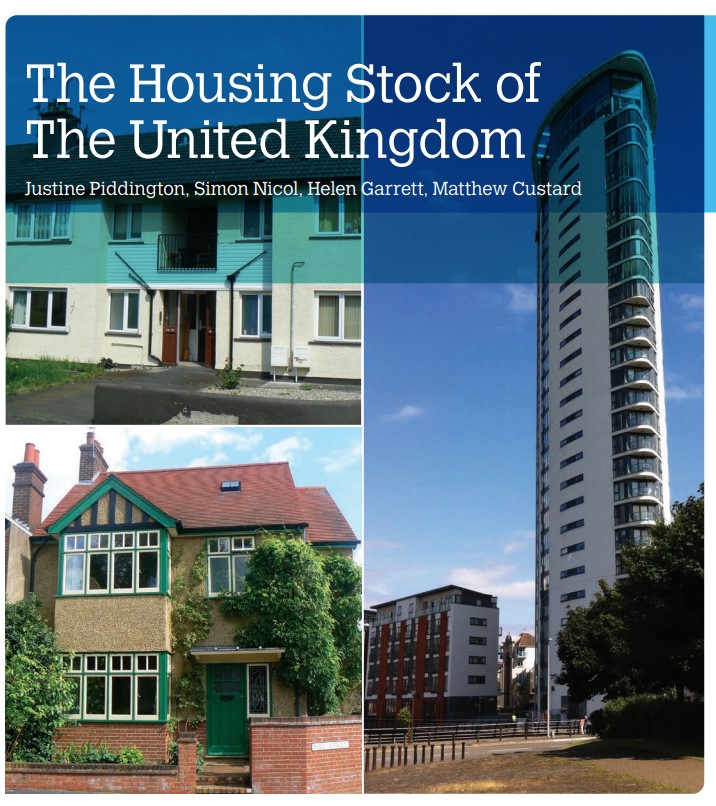UK Housing Stock
The first port of call on this discussion is the BRE Trust Report, the Housing Stock of the UK.
Extracts
There is a regular call for statistics on the United Kingdom (UK) housing stock, usually to compare them with statistics of other European or world nations. This is, however, not straightforward, as they have to be compiled from the four separate housing surveys of England, Scotland, Wales and Northern Ireland. The four surveys are undertaken over different timescales, with different sampling criteria and survey instruments. Even questions that appear similar are often subtly different. Scotland and Wales do not include vacant dwellings whereas England and Northern Ireland do.
The first house condition survey in the world, using trained inspectors to visit a representative sample of the national housing stock, was undertaken in England and Wales in 1967. At the time, slum clearance was going ahead at pace and new housebuilding was at a historical high. There was a growing feeling that housing renewal should be based on more robust evidence. A sub-committee of the Central Housing Advisory Committee recommended in its 1966 report: ‘Our older homes – a call for action’ that: “a national survey, scientifically designed and carried out by skilled investigators, was necessary to provide reliable data on house condition”, and the survey was the outcome of this.
The survey method was very simple and consisted of a one-page form to be completed by specially trained Public Health Inspectors, Figure 1.1. It was based on a sample of 6,000 randomly selected homes across England and Wales. The results were reported in Economic Trends in 1968.They showed that the condition of the housing stock in England and Wales was worse than expected. There were 15.7 million homes in England and Wales in 1967. Some 40% of these were built before 1919; 25% lacked a basic amenity (bath, wash hand basin, hot water); 19% lacked an indoor WC; 7% were in potential clearance areas; 5% required repairs exceeding £1,000 (around £17,000 at 2017 costs, based on the RPI index, the most relevant index of those dating back to 1967).
The 1967 housing survey was very significant because it provided the evidence base for future housing policies. These included the targeting of slum clearance programmes, rather than the previous ‘scattergun’ approach, and the identification of areas for grant-aided improvement work. It also enabled limited resources for public expenditure on housing improvement to be distributed on a scientific basis.
While the survey methodologies have evolved slowly over the years to ensure comparability of measurement with both each other and what has gone before, improvements in technology have been more dramatic. Data is now collected in the field by surveyors using a paper/digital pen system in England, Scotland and Wales, while Northern Ireland uses tablet PCs. The technology has improved efficiency and data quality and speeded up the reporting process. Headline results from all surveys are published within a year of the end of the latest fieldwork period.
The purpose of these surveys has been to monitor housing supply, conditions, energy performance and fuel poverty, and to direct policies towards continued improvement. The initial problems of unfitness, disrepair and lack of basic amenities identified in the early surveys were targeted with substantial investment programmes in the 1970s and 1980s and have largely been eradicated. During the 1980s, over £1 billion of public money per annum was being spent on Private Sector Renewal, based on the results of the UK national housing surveys. Due to the serious problems identified through the surveys, Wales received a proportionately larger share of the available funding, Figure 1.3.
2.2 Age, type and size of dwellings in the UK
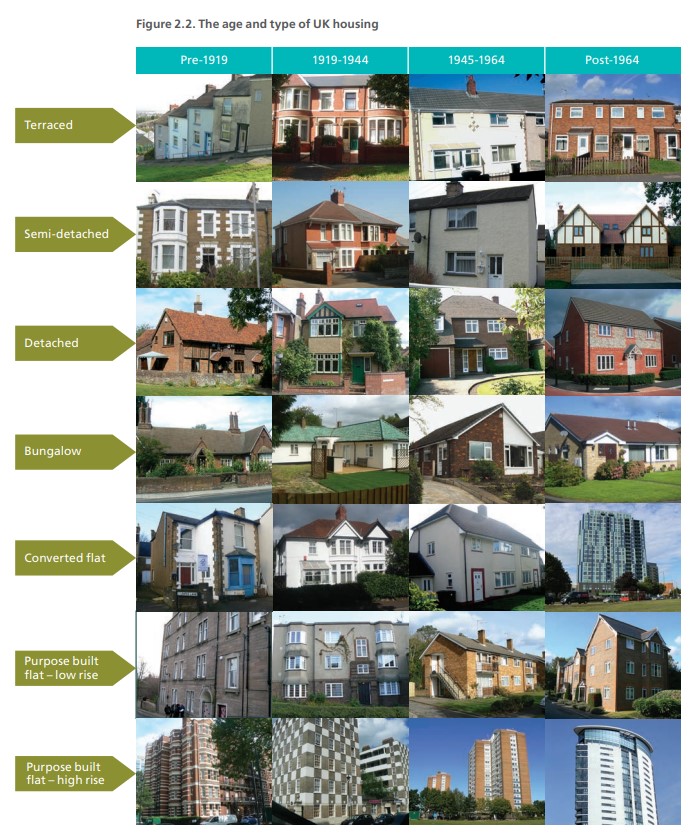 BRE The age and type of UK housing - Extract from BRE Trust Report, the Housing Stock of the UK.The housing stock of the United Kingdom is very diverse, representing a long history of housebuilding, local building preferences and materials, and policy interventions. Every dwelling type shown in Figure 2.2 is represented in each of the four UK nations but in differing proportions, Table 2.2
BRE The age and type of UK housing - Extract from BRE Trust Report, the Housing Stock of the UK.The housing stock of the United Kingdom is very diverse, representing a long history of housebuilding, local building preferences and materials, and policy interventions. Every dwelling type shown in Figure 2.2 is represented in each of the four UK nations but in differing proportions, Table 2.2
Dwelling construction
The great majority of dwellings in the UK are built in the ‘traditional’ way using brick, blockwork or stone and constructed on site. Prior to 1919 the walls would most likely have been solid. Cavity walls gradually became the dominant form of wall construction in the inter-war period with the transition taking place at different rates in different parts of the country. In recent years, there has been a growing number of homes built with timber frames supporting the roof structure, but finished to resemble traditional cavity walls, while larger blocks of flats tend to be built with concrete and steel frames.
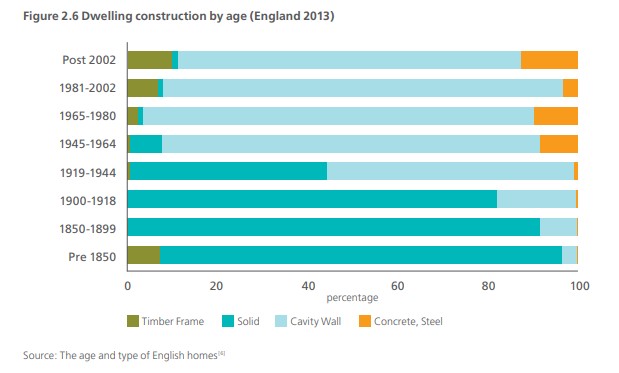
2.4 Dwelling heating, insulation and energy efficiency in the UK
Around eight in ten homes in the UK use a gas fired central heating system as the primary method for heating. Among those not using this heating method, electric storage heaters or central heating using oil were the most frequent types, Table 2.3. Northern Ireland has a distinctly different fuel mix from the rest of the UK due to an increased reliance on oil for domestic heat. (Figure 2.7).
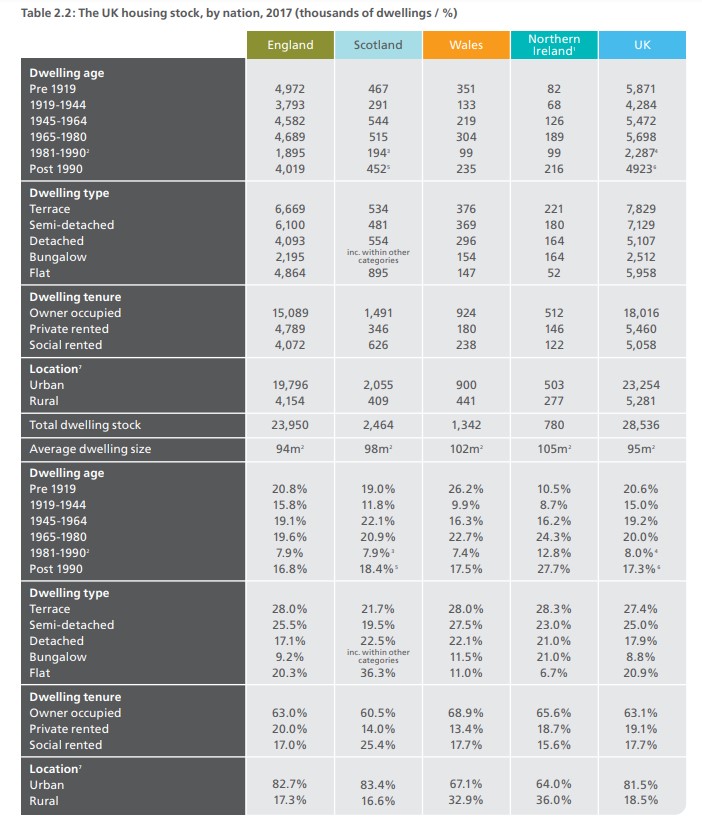 BRE The UK housing stock - Extract from BRE Trust Report, the Housing Stock of the UK.
BRE The UK housing stock - Extract from BRE Trust Report, the Housing Stock of the UK.
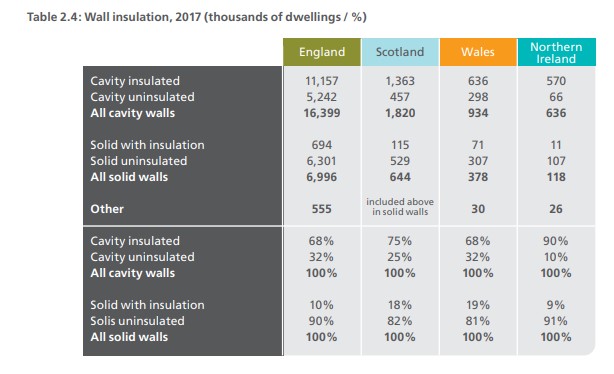 Dwelling insulation
Dwelling insulation
Fabric insulation is important in reducing greenhouse gas emissions from the housing stock as it acts to reduce demand for heat as well as delivering an improved level of thermal comfort and contributing to affordability of warmth. Insulation levels in the UK have risen steadily over time, driven by building regulations for new build housing and the retrofit of the existing stock. Cavity wall insulation is a common energy efficiency measure. The table below shows that Northern Ireland has the highest levels of insulated cavity walls in the stock at 90% of cavity wall dwellings filled, with England and Wales having the lowest penetration at 68%. Grant programmes and other schemes have had considerable success in driving the take-up of measures such as cavity wall insulation and while potential remains, future savings will have to be sought in other parts of the stock, such as the solid wall stock.
Energy efficiency
The Standard Assessment Procedure (SAP) is the UK Government’s recommended system for measuring the energy efficiency of housing. SAP is expressed on a logarithmic scale from 1 (very inefficient) to 100 (zero energy cost). The SAP ratings provide a measure of the annual unit energy cost of space and water heating for the dwelling under a set heating regime, which assumes specific heating patterns and room temperatures. The SAP rating takes into account a range of factors that contribute to energy efficiency, which include:
- – Thermal insulation of the building fabric;
- – Shape of the dwelling and exposed surfaces;
- – The materials of construction;
- – Efficiency and control of the heating system;
- – Fuel used for space and water heating, ventilation and lighting;
- – Ventilation and solar gain characteristics of the dwelling;
- – Renewable energy technologies
SAP is not affected by the individual characteristics of the household occupying the dwelling, nor by its geographical location. The SAP methodology is continually updated to reflect new technologies and knowledge. The version used in this report, for comparison purposes, is SAP 20124.
From Figure 2.8, it can be estimated that the average UK SAP for 2017 is approximately 62, which represents a rise of some 17 SAP points since 1996. Wales has the least energy efficient housing stock, despite great improvements in recent years, reflecting its high proportion of older, solid-walled buildings.
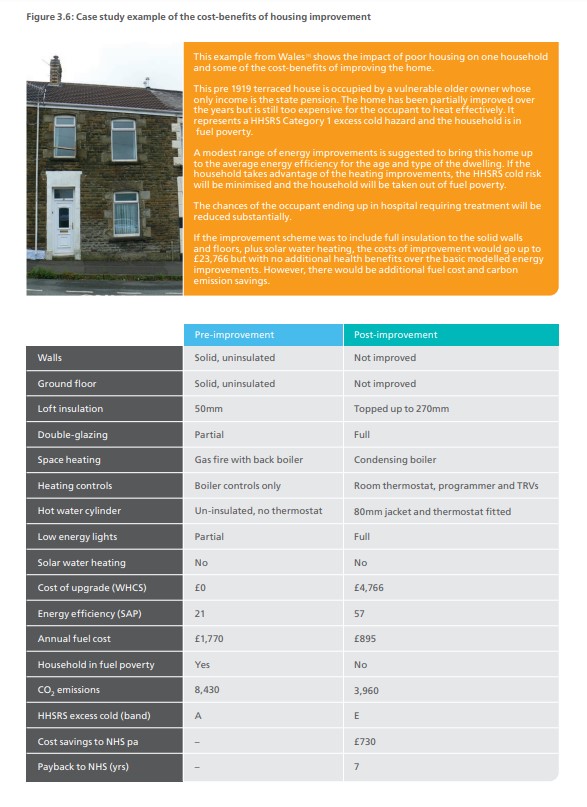
This is the end of the extracts from the BRE Trust Report, the Housing Stock of the UK. This is a significant and very interesting report and I thoroughly recommend that you spend the time to read it in its entirety. The extracts are quite extensive, but only represent a small proportion of the whole report.
Combining two Tables/Figures from the report we can calculate that nearly 7 million homes, about 30% of the England Housing Stock are Solid Wall properties which may be considered Hard To Heat
| Table 2.2: The UK housing stock | Figure 2.6 Dwelling construction by age (England 2013) | |||
| England | Solid walls | Approx Solid walls | Hard to heat | |
| Dwelling age | 6,982,230 | |||
| Pre 1919 | 4,972,000 | 95% | 4,723,400 | |
| 1919-1944 | 3,793,000 | 45% | 1,706,850 | |
| 1945-1964 | 4,582,000 | 10% | 458,200 | |
| 1965-1980 | 4,689,000 | 2% | 93,780 | |
| 1981-1990 | 1,895,000 | 0% | 0 | |
| Post 1990 | 4,019,000 | 0% | 0 | |
| Dwelling type | ||||
| Terrace | 6,669,000 | |||
| Semi-detached | 6,100,000 | |||
| Detached | 4,093,000 | |||
| Bungalow | 2,195,000 | |||
| Flat | 4,864,000 | |||
| Dwelling tenure | ||||
| Owner occupied | 15,089,000 | |||
| Private rented | 4,789,000 | |||
| Social rented | 4,072,000 | |||
| Location | ||||
| Urban | 19,796,000 | |||
| Rural | 4,154,000 | |||
| Total dwelling stock | 23,950,000 | |||
| Average dwelling size | 94 m2 | |||
| Dwelling age | 29.15% | |||
| Pre 1919 | 20.80% | 95% | 19.7600% | |
| 1919-1944 | 15.80% | 45% | 7.1100% | |
| 1945-1964 | 19.10% | 10% | 1.9100% | |
| 1965-1980 | 19.60% | 2% | 0.3920% | |
| 1981-1990 | 7.90% | 0% | 0.0000% | |
| Post 1990 | 16.80% | 0% | 0.0000% | |
| Dwelling type | ||||
| Terrace | 28.00% | |||
| Semi-detached | 25.50% | |||
| Detached | 17.10% | |||
| Bungalow | 9.20% | |||
| Flat | 20.30% | |||
| Dwelling tenure | ||||
| Owner occupied | 63.00% | |||
| Private rented | 20.00% | |||
| Social rented | 17.00% | |||
| Location | ||||
| Urban | 82.70% | |||
| Rural | 17.30% |
Using the above data and the case study;
| Hard to heat | Cost of upgrade | Annual Fuel Cost | CO2 emissions | Cost savings to NHS pa | Annual Benefit £ | Pay back period years |
| 1770 | 8430 | |||||
| 895 | 3960 | |||||
| 4766 | 875 | 4470 | 730 | |||
| 6,982,230 | 33,277,308,180 | 6,109,451,250 | 31,210,568,100 | 5,097,027,900 | 11,206,479,150 | 2.97 |
The sums of money required are huge but the payback period is very impressive at only 3 years. This is from a economic perspective though as different bodies benefit form the savings. If you only consider the Annual Fuel Cost savings the pay back period of the whole of the Cost of upgrade is just under 5.5 years, whereas the Cost savings to the NHS is 6.5 years.
It would seem to me that given these figures it would be a good investment for the Government to pay for the cost of the upgrade to the housing stoke just to get the Savings to the NHS. Especially, with the scale of purchasing that would involve, within the timescales of COP in Glasgow [The 26th UN Climate Change Conference, November 2021, at the Scottish Event Campus (SEC) in Glasgow], that the Cost of upgrade could be kept to a price of £4,766.
From an individual perspective, I think the actual cost of the upgrades listed would be at least four times as much.
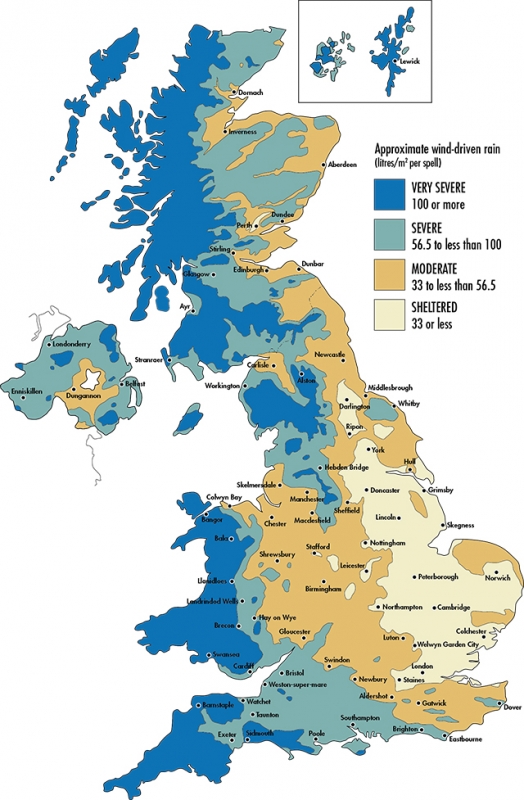 In addition to the 'hard to heat' challenge of solid walls, according to the same report, 5,242,000 homes in England have cavity walls as yet uninsulated, 32%. However, there appears to be no information about the proportion of properties which should not have full cavity wall insulation due to the location exposure to wind driven rain.
In addition to the 'hard to heat' challenge of solid walls, according to the same report, 5,242,000 homes in England have cavity walls as yet uninsulated, 32%. However, there appears to be no information about the proportion of properties which should not have full cavity wall insulation due to the location exposure to wind driven rain.
Before we discuss the impact of rain to insulation, we sound consider the veracity of the report by virtue of the body who produced the above report, the BRE Trust.
From Companies House;
BRE Trust (the "Trust") is a company limited by guarantee (Company number 03282856) and is registered as a charity in England and Wales (No 1092193) and in Scotland (No SCO39320). The Trust was established to provide independent, non-sectorial ownership of the Building Research Establishment, an Executive Agency of the Department of the Environment, when it was transferred to the private sector in March 1997. The Trust is governed by its most recent Articles of Association which were approved by a meeting of members on 6th March 2019. In addition, the Trust provides independent ownership of BRE Group Limited ('BRE Group') which in turn is the owner of businesses resulting from the privatisation of the Building Research Establishment. The Trust protects the independence of BRE Group to ensure that its advice and research remain objective and free from bias. BRE Group continues to have a strong reputation, both nationally and in the international arena, as an impartial and respected consultancy, science and research organisation. BRE Group Limited is the holding company for Building Research Establishment Limited, BRE Global Limited which are established in England and Wales and BRE Global Assurance (Ireland) Limited, a company established and resident in the Republic of Ireland. These subsidiaries in tum are owners of other trading companies in the UK and the People's Republic of China.
I have been fortunate enough to have visited the Building Research Establishment in a work capacity and have faith in their work and this report.
The adjacent map was found on the LABC website.
The possibility of wind-driven rain penetrating a cavity wall depends on the exposure level of the site or building. This varies according to where it is in the country, topography and various site factors.
Following problems with rainwater penetration in parts of the UK in the 1980’s, Approved Document C of the Building Regulations was introduced in 1985 and highlighted where consideration must be given.
The principal change was that the use of full-fill cavity wall insulation was not permitted in areas of very severe exposure to wind-driven rain where fairfaced masonry is used for the outer leaf. However, the rules also reflected the reduced risk where impermeable and rendered outer leaf constructions were used and therefore permitted the use of full fill insulation.
At the time of introduction, the standard cavity width between the inner and outer leaf of masonry was significantly narrower than it is today (often just 50mm). Energy efficiency standards have progressively improved since then and cavity widths have increased to accommodate greater thicknesses of insulation. It is now more common to see cavities wider than 100mm in both new homes and extensions.
It is widely recognised that as cavity widths increase the likelihood of rain penetration reduces.
The rules in Approved Document C have changed to reflect the alterations and in the current 2010 edition it is permissible to build with full-fill insulation behind tooled flush jointed fair faced masonry providing the cavity is a minimum of 150mm wide. However, this is not the case with Warranty provider technical standards where the restriction on full-fill remains.
Old Housing Stock, decarbonisation towards net Zero
It is therefore evident that having an old housing stock creates problems whilst attempting to reduce carbon footprint, both in terms of nationally and individually.
In our quest for a carbon-friendly future, decarbonising some industries is proving far more challenging than others. One of the UK's biggest challenges is home heating, which is yet to be electrified (so unable to reap the benefits of cleaner, greener electricity), and accounts for 14% of our total carbon emissions.
17 million UK homes still use gas boilers, burning tonnes of fossil fuels to stay warm. With over 1.5 million people replacing their boilers every year, there are huge gains to be made, but we need affordable alternatives - hardware that helps us bring the benefits of cleaner, greener renewable energy to these hard-to-reach sectors.
A Guide to Decarbonisation of Heat
Decarbonising heat is key to achieving Net Zero, and innovators have a vital role to play. Here is our overview of the decarbonisation challenge and how we can tackle it through low carbon home heating innovation.
Why do we need to decarbonise heat?
Heating is the United Kingdom’s biggest source of carbon emissions, which are the fossil fuel gases that contribute to climate change.
In June 2019, the UK Government committed to a Net Zero carbon emissions target across the economy by 2050.
How much does heating contribute to UK carbon emissions?
Heating accounts for about 37% of total UK carbon emissions when including industrial processes. The breakdown of UK carbon dioxide emissions from heating is:
Space heating (including a relatively small amount of cooling) = 17%
Hot water = 4%
Cooking = 2%
Industrial processes = 14%.
Of the 17% of carbon emissions from heating (and cooling) in buildings, about 13-14% can be attributed to domestic homes.
Hot water use is significant in the health, hospitality, emergency services and education sectors, driven by demand for washing facilities. Heat demand for cooking and catering is high in the hospitality sector.
Heat is used in a range of industrial processes, from high temperature blast furnaces for making iron through to lower temperature steam in food thawing processes.
Top 5 reasons why decarbonising heat is so hard:
Net Zero targets – under plans to reduce carbon emissions to Net Zero by 2050, certain sectors of the economy will continue to emit carbon that will need to be offset. But that means tougher targets for heating, with most buildings needing to become zero carbon.
Size of the challenge – only about 5% of homes currently have low carbon heating. The UK is dominated by fossil fuel gas – with 85% or about 24.5 million homes heated by natural gas.
No silver bullet solution – low carbon or carbon neutral heating solutions already exist, however a top-down “blanket” solution such as all-electric or all-hydrogen is projected to cost twice (2.28%) or three-and-a-half times (3.51%) as much respectively compared to a bottom-up approach that chooses the best low carbon heating solutions on a place by place basis.
Poor energy efficiency – UK building stock is generally of poor thermal efficiency. Around 2/3 of households suffer from either damp, drafts, or overheating – wasting energy and making home life uncomfortable.
Incentives and workforce – almost half of people (48%) have no awareness of low carbon heating and current incentives do not encourage many households to switch to low carbon heating. For every 100 qualified gas engineers in the UK there are less than two low carbon heating engineers, while 74% of heating professionals were not fully confident in selecting suitable low carbon heating for clients.
What do Net Zero targets mean for heating?
Under the UK’s new 2050 Net Zero carbon emission targets, the Committee on Climate Change expects certain parts of the economy – such as air travel, agriculture and cement-making – will continue to emit some carbon. These emissions will need to be captured using Bioenergy and Carbon Capture and Storage technology or be offset through measures such as carbon sequestration by planting trees.
But for heating, the overwhelming majority of buildings and homes in the UK will need low carbon solutions that enable them to reach near zero carbon by 2050. Though there will be exceptions and some hard-to-treat buildings could continue to be responsible for significant emissions.
What is the size of the decarbonisation challenge?
Currently, heating in the UK is dominated by fossil fuels, with 85% or about 24.5 million homes (and over two million businesses) supplied directly by the mains gas grid. Converting them to low carbon heating over the next 30 years to 2050 is a similar sized task as the switch to central heating – which took 35 years to increase from 30% to 95% of homes from 1970s,
In comparison, 8.6% of homes are heated by electricity generated by traditional storage heaters or modern heat pumps, 4.1% by heating oil, 0.8% by solid fuel, and 0.7% by LPG. In total, around 3.7 million homes in Britain use non-mains gas fuels for their primary heating, with only the Netherlands having a higher penetration of natural gas for heating across Europe.
Yet 90% of people say they prefer their fossil fuel gas boiler to low carbon alternatives and almost half of people (48%) are not aware that gas boilers are a source of carbon emissions.
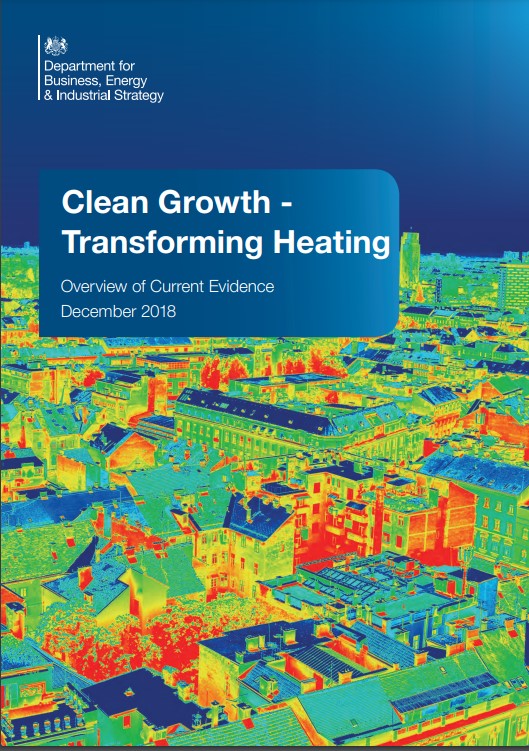
Extracts from the BEIS report Clean Growth - Transforming Heating.
1.1 Heating is central to our lives. In our homes, we rely on it for comfort, cooking and washing. Businesses need heating and cooling for productive workplaces and heat is integral to many industrial processes. It is the biggest reason we consume energy in our society.
1.2 Heat accounts for over a third of the UK’s greenhouse gas emissions. Under the Climate Change Act 2008, the Government has committed to reducing annual greenhouse gas emissions by at least 80% by 2050 and has recently sought advice from the Committee on Climate Change as to when the UK should achieve net zero emissions across the economy. Meeting our existing Climate Change Act commitments will require decarbonising nearly all heat in buildings and most industrial processes. If we fall short of this, deeper emissions reductions will need to be made in sectors that may prove less cost-effective to decarbonise, such as agriculture.
1.3 Over recent years, lower carbon technologies have provided an increasing proportion of our nation’s heating. Electric heat pumps and biomass boilers are used in many homes and businesses and increasing volumes of biomethane are blended with natural gas in the gas grid. Meanwhile a substantial number of customers, particularly in premises off the gas grid, continue to use direct electric heating systems which have become cleaner as the power sector continues to decarbonise.
1.4 However, heating remains the largest source of our greenhouse gas emissions. Most of the heating in our buildings and industries is delivered by fossil fuels; natural gas remains the predominant source of heating for the vast majority of customers connected to the grid. The prevalence of the gas grid presents a particular challenge to the UK in enabling the necessary shift to low carbon heat. Whichever approaches are taken, the way heating is supplied to nearly 24 million homes, businesses and industrial users connected to the gas grid will need to change. Ensuring this transition is as smooth as possible represents a major national challenge over the coming years.
The Government’s approach to heat
decarbonisation
1.5 The Government has emphasised the central importance of decarbonising heat to achieve our Industrial Strategy and clean growth objectives, as we transition to a low carbon economy. The Government’s approach to heat decarbonisation encompasses a range of programmes and initiatives, underpinned by innovation and “learning by doing”, which aims to achieve:
- a reduction in heat demand, by seeking to:
- – build a market for energy efficiency, particularly among owner occupiers;
- – improve the way businesses use energy, to support delivery of our ambition to reduce business energy use by 20% by 2030;
- – improve the energy efficiency of new and existing buildings via updates to building standards and through the Industrial Strategy Buildings Mission, to halve the energy used in new buildings by 2030; and,
- – work with industry to reduce energy demand through the £18m Industrial Heat Recovery Support Programme and the £315m Industrial Energy Transformation Fund.
- substantial growth in no or low-regrets low carbon heating in the shorter term by supporting the deployment of:
- – heat networks: the Heat Networks Investment Project (HNIP) is a Government Major Project which will invest £320m of capital funding in heat network projects through grants and loans. This is provided as ‘gap funding’ to leverage around £1bn of private and other investment, and pave the way for the continued growth of the UK heat networks market; and,
- – lower carbon heating solutions: through the Renewable Heat Incentive we are spending £4.5bn between 2016 and 2021 to support innovative low carbon heat technologies in homes and businesses, such as heat pumps, biomass boilers and solar water heaters. We have also reformed the Renewable Heat Incentive to focus the scheme towards long term decarbonisation through greater uptake of technologies such as heat pumps and biomethane. Beyond the Renewable Heat Incentive, our ambition is to phase out the installation of high carbon fossil fuel heating in buildings off the gas grid during the 2020s, starting with new buildings.
- a new long-term policy framework for heat: to bring about and support the national transition required to meet our long-term emissions reduction commitments. This framework must:
- – ensure that appropriate support is in place for consumers;
- – enable the most cost-effective transition across energy industries and infrastructure; and,
- – contend with the uncertainties arising from the multi-decade heat decarbonisation timetable. Advances in technologies may open up new solutions, and economywide developments such as the decarbonisation of transport and power generation may alter the feasibility of others.
This is just a short extract from the beginning of an extensive 136 page report, again worth reading; - BEIS report Clean Growth - Transforming Heating.
I think that the above gives a taste of the scale of the problem posed by having such a large proportion of old housing stock, on a national level. This transfers down to an individual level in terms of the base condition of the home, and the requirements necessary the reduce the carbon footprint.














